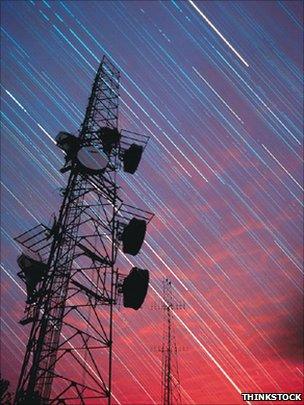Mobile map: Some questions answered
- Published
- comments

On Monday we launched our mobile mapping experiment which aims to use crowdsourcing (a word John Humphrys did not like one bit when we discussed it on Today, external!) to work out what sort of coverage we are getting from our phones.
There has been plenty of enthusiasm for the project - but also some questions about its methods and aims. So I thought I'd try to answer some of them.
How many people have downloaded the UK 3G survey app so far?
The latest estimate 36,000, and they are spread right across the UK. - from Cornwall to the Scottish isles.
What kind of data are you now getting?
Each of those users is now sending data back to the project showing where they are, what network they are using and the kind of mobile signal they are getting - HSDPA, UMTS, EDGE, GPRS or none. It's not recorded all the time - just in short windows in order not to use too much battery power.
What kind of map will that produce?
We hope to able to plot information by operator so that consumers will get a good idea of coverage in their area. The more users we get, the more granular the data we will be able to plot on the map. Every extra download means another street covered.
The app is draining my phone battery - what can I do?
I too had this experience on the phone I'm using for the survey. Now though, Epitiro, which makes the app, has issued an update which makes it less heavy on the battery. What you can do is switch off GPS, which should sort the problem completely, though it will mean we will get less detailed location data. But Epitiro is promising another update next week which will decrease the level of testing, and save more power even if you leave GPS switched on.
Why is the app only available for Android phones?
As we explained earlier, other mobile platforms make it much harder to capture the data automatically, without some active input from the user. What's more developing different apps for every operating system would be quite a challenge, so we've gone with Android as the easiest system to use. Given how many downloads we've seen, that seems to be working.
OpenSignalMaps already do this - why aren't you using its app?
Collating all the data and then plotting it on a map is already going to be a challenge for our web team - having more than one dataset would make it impossible in the time available. But we've been talking to OpenSignalMaps, whose Android application you can download here, external.
Their map plotting mobile phones masts across the UK already looks very impressive, so at the end of the survey period we're going to try to look at their data and maps alongside our research .
Why is the BBC doing this?
While the number of downloads shows how much interest there is in the mapping project, some people are suggesting that this is just not a job the BBC should be doing. Well blame me and other members of the technology team - we've been frustrated by the lack of information about the state of our phone networks and somehow persuaded colleagues that we should do something. Just as the BBC sometimes commissions opinion polls, it seems to me perfectly sensible for us to undertake this kind of survey.